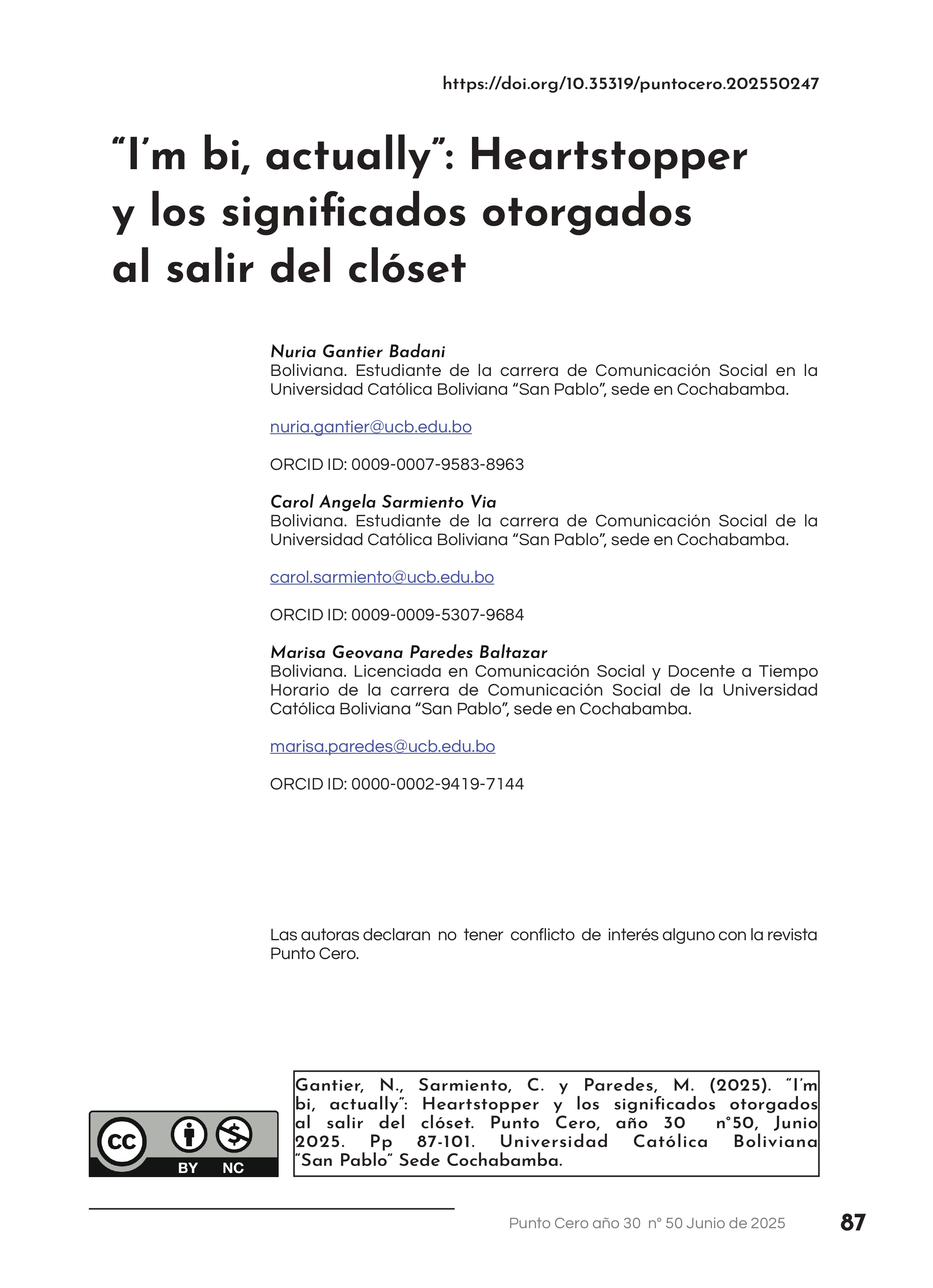“I’m bi, actually”: Heartstopper y los significados otorgados al salir del clóset
DOI:
https://doi.org/10.35319/puntocero.202449247Palabras clave:
Heartstopper, Comunidad LGBTQ , Significado, Identidad, Salir del clósetResumen
La investigación se centra en la representación de la Comunidad LGBTQ+ a través de medios audiovisuales, con un enfoque particular en la miniserie Heartstopper, y con el objetivo de comprender los significados que los jóvenes que han visto la miniserie le otorgan. La metodología propuesta incluye un enfoque correlacional, un diseño no experimental y cualitativo, utilizando revisión bibliográfica y grupos focales como una de las herramientas principales. La investigación se centra en dos escenas, una de cada temporada, donde se contempla al personaje principal, Nick Nelson, saliendo del clóset. Los resultados evidencian que la audiencia comprende esta miniserie como crucial para la juventud mientras le atribuyen significados a su identidad, al proceso de salir del clóset y a la representación de personajes LGBTQ+.
Citas
Advocates for Youth. (s. f.). Creo que soy asexual. https://www.advocatesforyouth.org/wp-content/uploads/2019/06/ITIMB-ACE-spanish-translation.pdf
Attitude Magazine (Director). (2023, febrero 7). Alice Oseman knows exactly how Heartstopper will end and teases future TV seasons. https://www.youtube.com/watch?v=FP481ZnUr5M
Boustani, K., & Taylor, K. A. (2020). Navigating LGBTQ+ discrimination in academia: Where do we go from here? The Biochemist, 42(3), 16-20. https://doi.org/10.1042/BIO20200024 DOI: https://doi.org/10.1042/BIO20200024
Burke, P. J., & Stets, J. E. (2009). Identity Theory. Oxford University Press. DOI: https://doi.org/10.1093/acprof:oso/9780195388275.001.0001
Buxó, J., & De Miguel, J. (1999). De la investigación audiovisual: Fotografía, cine, vídeo, televisión. Anthropos Editorial.
Collins, P. H., & Bilge, S. (2019). Interseccionalidad. Ediciones Morata.
Corrigan, P., & Matthews, A. (2009). Stigma and disclosure: Implications for coming out of the clóset. Journal of Mental Health, 12, 235-248. https://doi.org/10.1080/0963823031000118221 DOI: https://doi.org/10.1080/0963823031000118221
Gantier Badani, N., & Sarmiento Via, C. A. (2023). Perfil de investigación.
García Canclini, N. (1999). El consumo cultural: Una propuesta teórica. Construcción teórica y líneas de investigación, 2.
Goldberg, A. E. (2016). The SAGE Encyclopedia of LGBTQ Studies. SAGE Publications. DOI: https://doi.org/10.4135/9781483371283
Goyeneche-Gómez, E. (2012). Las relaciones entre cine, cultura e historia: Una perspectiva de investigación audiovisual. Palabra Clave, 15(3), 387-414. DOI: https://doi.org/10.5294/pacla.2012.15.3.1
Hachette Schools (Director). (2022, junio 6). Alice Oseman answers your Heartstopper questions. https://www.youtube.com/watch?v=vy-kMPCZA_U
Lozano Verduzco, I., & Padilla Gámez, N. (2023). Salir del clóset desde la perspectiva sistémica: Un estudio de caso. Revista Puertorriqueña de Psicología, 34(1), 76-90. DOI: https://doi.org/10.55611/reps.3401.06
Lucero Vargas, J. (2019). Percepciones de la sociedad boliviana acerca de la Comunidad LGBT. Orbis Tertius - UPAL, 3(5), Art. 5. https://doi.org/10.59748/ot.v3i5.36 DOI: https://doi.org/10.59748/ot.v3i5.36
Moscovici, S. (1979). El psicoanálisis, su imagen y su público. Huemul.
Netflix. (2022). Heartstopper | Sitio oficial de Netflix. https://www.netflix.com/bo/title/81059939
Oseman, A. (s. f.). The History. Alice Oseman. Recuperado 7 de abril de 2024, de https://aliceoseman.com/heartstopper/the-history/
Pohlen, J. (2015). Gay & Lesbian History for Kids: The Century-Long Struggle for LGBT Rights, with 21 Activities. Chicago Review Press.
Prada Oropeza, R. (1993). Cine, discurso fílmico y semiótica cinematográfica [Article]. Centro de Investigaciones Lingüístico Literarias. Universidad Veracruzana. https://cdigital.uv.mx/
Ramírez-Bravo, A., Martínez-José, J. R., & Pérez Lozano, E. A. (2022). El ABC para conocer a la comunidad LGBT+. RA RIÓ GUENDARUYUBI, 5(14), 6-17. https://doi.org/10.53331/rar.v5i14.9629 DOI: https://doi.org/10.53331/rar.v5i14.9629
severusnapesidehoe (Director). (2022, abril 29). [Tik Tok]. https://vm.tiktok.com/ZMMgMD2CH/
Tajfel, H., & Turner, J. C. (2004). The Social Identity Theory of Intergroup Behavior. En Political Psychology. Psychology Press. DOI: https://doi.org/10.4324/9780203505984-16
Tanti, C., Stukas, A. A., Halloran, M. J., & Foddy, M. (2011). Social identity change: Shifts in social identity during adolescence. Journal of Adolescence, 34(3), 555-567. https://doi.org/10.1016/j.adolescence.2010.05.012 DOI: https://doi.org/10.1016/j.adolescence.2010.05.012
Vitaliti, J. M., & Onofrio Cipolla, R. S. (2011). Salir del clóset: La aceptación del encuentro con uno. https://www.aacademica.org/jose.maria.vitaliti/19.pdf
Walters, M. (2009). What’s up with Webcomics? Visual and Technological Advances in Comics. Interface: The Journal of Education, Community and Values. https://www.semanticscholar.org/paper/What%27s-up-with-Webcomics-Visual-and-Technological-Walters/d0a1a3ab18d35fabb8a49192ec99b470fd0ad6eb
Zavala Kahn, S. (2019). La representación de personajes LGBT en el cine. Ventana Indiscreta, 022, Art. 022. https://doi.org/10.26439/vent.indiscreta2019.n022.4652 DOI: https://doi.org/10.26439/vent.indiscreta2019.n022.4652

Descargas
Publicado
Cómo citar
Número
Sección
Licencia
Derechos de autor 2025 Revista Punto Cero

Esta obra está bajo una licencia internacional Creative Commons Atribución-NoComercial 4.0.








